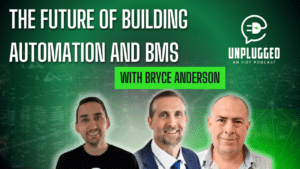Hosts Phil Seboa and Ed Fuentes are joined by Bryce Anderson, founder of Lifecycle Controls, to explore the evolving landscape of Building Management Systems (BMS). With over 25 years of experience, Bryce shares his insights on industry challenges, the importance of continuous education, and practical solutions for integrating technology effectively. This article will delve into why these points are beneficial to readers navigating the complexities of BMS.
The Challenges of BMS in Commercial Offices
Bryce Anderson highlights the hurdles that large corporations face with BMS in commercial settings. “We see a lot of inefficiencies that stem from issues with installation and commissioning,” Anderson points out, “and many maintenance tasks are done unnecessarily, questioning the return on investment.” Companies often invest significant amounts in preventive maintenance contracts, yet these costs may not translate into real value.
One noteworthy example discussed is a $100,000 per year preventative maintenance contract. Over a decade, that’s a $1,000,000 investment. The return on such an investment becomes questionable if regular maintenance isn't resolving critical issues, especially when inefficiencies silo through the initial installation and commissioning stages. "By addressing these root causes," says Bryce, "we can improve overall system performance and increase the ROI on maintenance contracts." This necessitates a shift in industry standards and practices to ensure that maintenance activities genuinely enhance system performance and cost-effectiveness.
Importance of Ongoing Industry Education and Learning
Bryce stresses the necessity for ongoing education within the BMS industry. “Achieving meaningful impact on energy efficiency requires scalable solutions,” Anderson says. However, this is not just about new constructions. He emphasizes a keen focus on upgrading existing buildings. With continuous advancements in technology, staying updated is crucial for achieving and maintaining energy efficiency.
Through training and coaching, professionals in the field can stay informed about evolving technologies and best practices. This continuous learning approach leads to more efficient energy management and better integration of BMS with the latest technology standards and practices. “We need to rethink how we’re incorporating education within our daily practices and adopt a lifelong learning approach,” Bryce advises. Creating a culture that prioritizes ongoing learning will result in an industry that is both adaptable and proficient in dealing with technological advancements and operational challenges.
Human Interaction with Technology
Contrary to the trend of relying heavily on artificial intelligence (AI), Bryce Anderson emphasizes the human element in maximizing building assets. “Technology alone isn’t enough; it’s the interplay between humans and technology that drives true efficiency,” Anderson explains. He believes that integrating trained personnel who understand BMS intricacies with advanced technologies yields better results than relying solely on automated solutions.
Anderson critiques the common approach of purchasing technology for its own sake. Effective integration requires a restructured approach to maintenance contracts that strikes a balance between human expertise and technological tools. Bryce states, “Big building owners often miss the gains of technology by not marrying it with skilled hands.” By combining expertise with technology, buildings can harness the full potential of their systems, leading to greater efficiency and sustainability.
Key Quotes From The Episode
- Bryce Anderson points out, “We see a lot of inefficiencies that stem from issues with installation and commissioning.”
- Ed Fuentes highlights, “Having a champion within the business who believes in and drives the transformation is crucial.”
- Phil Seboa encourages listeners, “We need to rethink how we’re incorporating education within our daily practices and adopt a lifelong learning approach.”
Key Takeaways
- Installation and Maintenance: Addressing inefficiencies from the ground up will improve overall system performance and increase the ROI on maintenance contracts.
- Focus on Education: Ongoing training and education ensure industry professionals can manage and utilize the latest BMS technologies effectively.
- Human and Technology Integration: Effective BMS operation requires a synergy between human skills and technological tools to maximize building performance.
Wrap Up
This episode with Bryce Anderson dives deeply into the challenges of BMS in commercial offices, underscores the importance of continuous education within the industry, and highlights the need for effective integration of technology and skilled personnel. These insights can help building owners, managers, and BMS professionals optimize their systems for better performance and efficiency.
For those looking to enhance their BMS practices, consider scrutinizing your current maintenance contracts, investing in BMS-related training programs, and integrating skilled technicians with advanced technological solutions. These steps can ensure your systems work at their peak performance, providing both energy efficiency and cost savings.
About the Guest
Bryce Anderson is the founder of Lifecycle Controls, a company specializing in BMS design, training, coaching, and mentoring. With extensive experience in the BMS and BAS industry, Bryce has worked across South Africa, London, and Australia, contributing significant advancements to the field. His work emphasizes practical solutions that combine advanced technology with skilled human intervention to maximize building efficiency and sustainability.
Implementing the strategies discussed by Bryce can guide the BMS industry towards achieving higher efficiency and better technological adaptation.
Connect with Bryce on LinkedIn:
https://www.linkedin.com/in/bryce-anderson17
Learn more about Lifecycle Controls: https://www.lifecyclecontrols.com.au/



